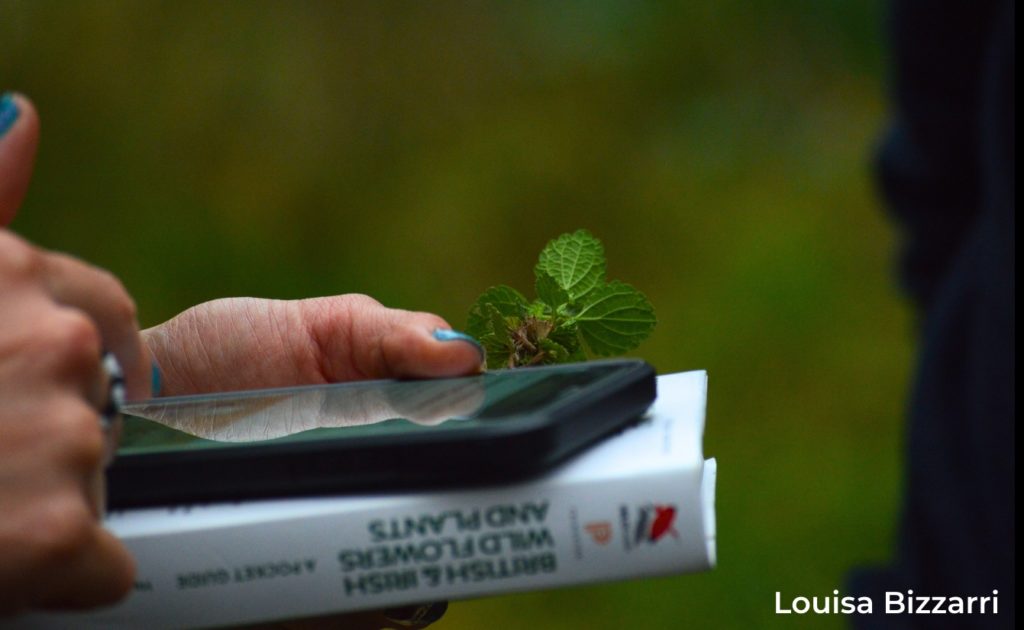This article is the second instalment of our London Day of Nature 2024 recap. We want to share the valuable insights of the day both with readers who couldn’t attend and to re-inspire those who could. Over two articles – read Part 1 here – we’re highlighting the key takeaways from the event. We hope you will be able to connect with the presentations and workshops that made the day memorable and share in the joy and curiosity they inspired among attendees. You can also add to our new Mapping London’s Green Actions map, introduced at LDN24, here.
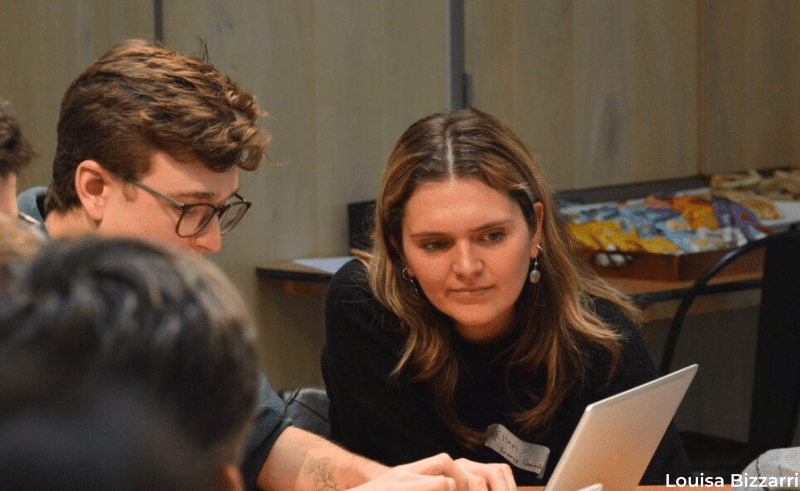
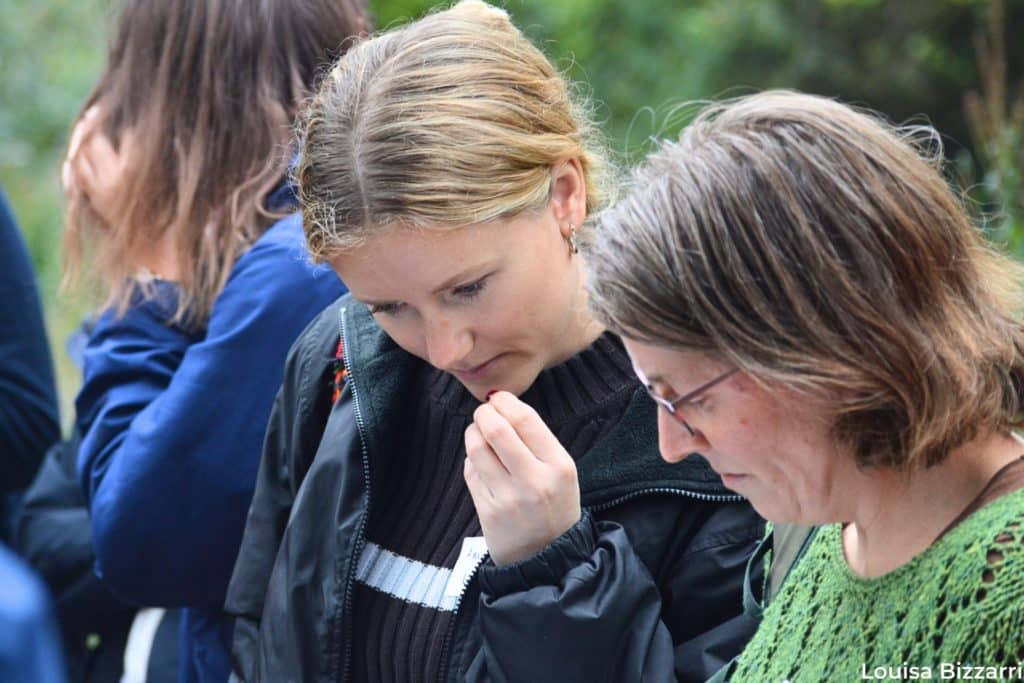
Workshoppers collaborate and explore Camley Street Natural Park in this selection of photos from the London Day of Nature, Saturday 26th October 2024. All photos Louisa Bizzarri.
If you attended, there’s still time to complete the feedback form here – we really value it!
The talks and brilliant speakers in the first half of LDN24 provided a succinct summary on the planning and environmental contexts Londoners find themselves navigating, locally to nationally. In addition to updates on London’s Green Infrastructure policies, we celebrated local group achievements, were inspired to get involved ourselves and discussed the dangers of the intellectual and physiological misconnections that can lie between policy and practice. Part 2 of our GiGLer newsletter series on London Day of Nature 2024, celebrates more speakers instilling passion, skill and knowledge through projects to empower locals across London’s divides to take environmental action together, for the love of their local patch.
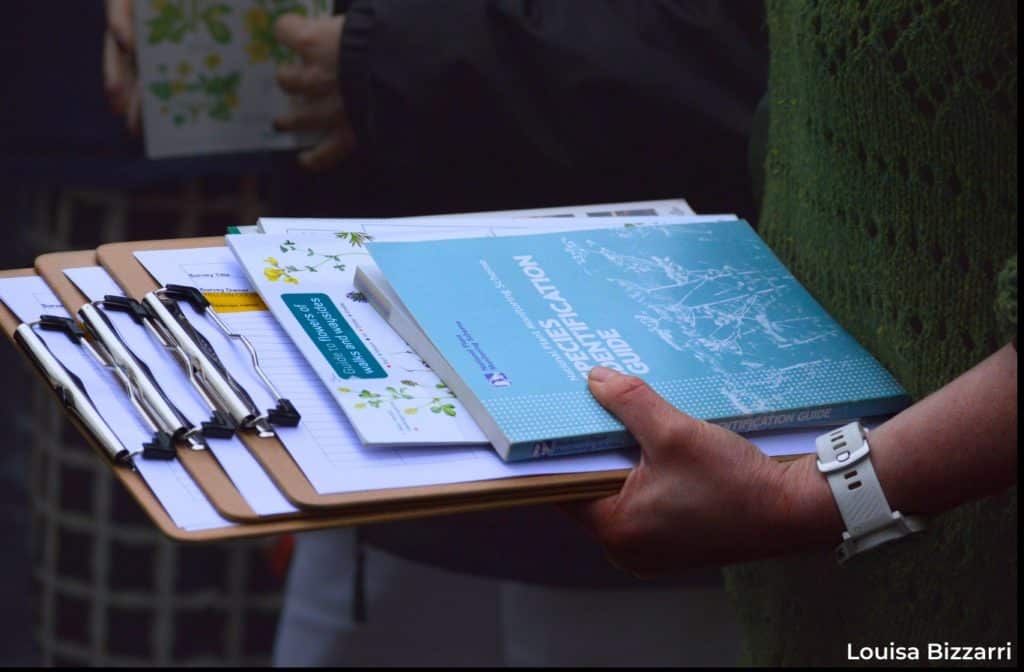
Download the recording sheet and extra recording tips from the delegate pack here, or access it on your phone using the QR code below.
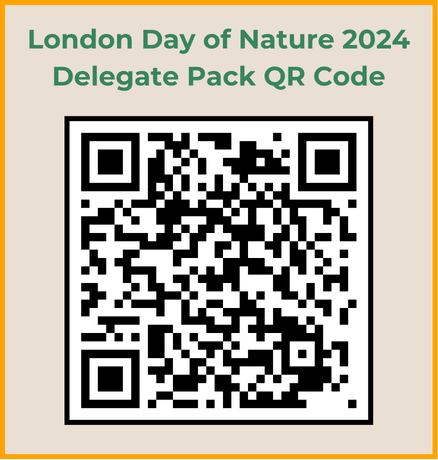
Education and Upskilling for Nature and Communities
Kicking off the second half of the day, both the Bumblebee Conservation Trust and the Royal Horticultural Society talks centred on education and embedding nature skills into the average Londoners’ everyday, from our families to our schools, to places of worship and places of work and even our healthcare system.
Buzzing in the East End from the Bumblebee Conservation Trust represents the best in sustainable, targeted, taxon-specific projects. It’s aim is to assess the status of rare bumblebee species in East London and through species and habitat identification training, embed the skills needed to do so in locals and landowners. Scarlett Weston, Project Development Officer, took us through the project’s successes to date.
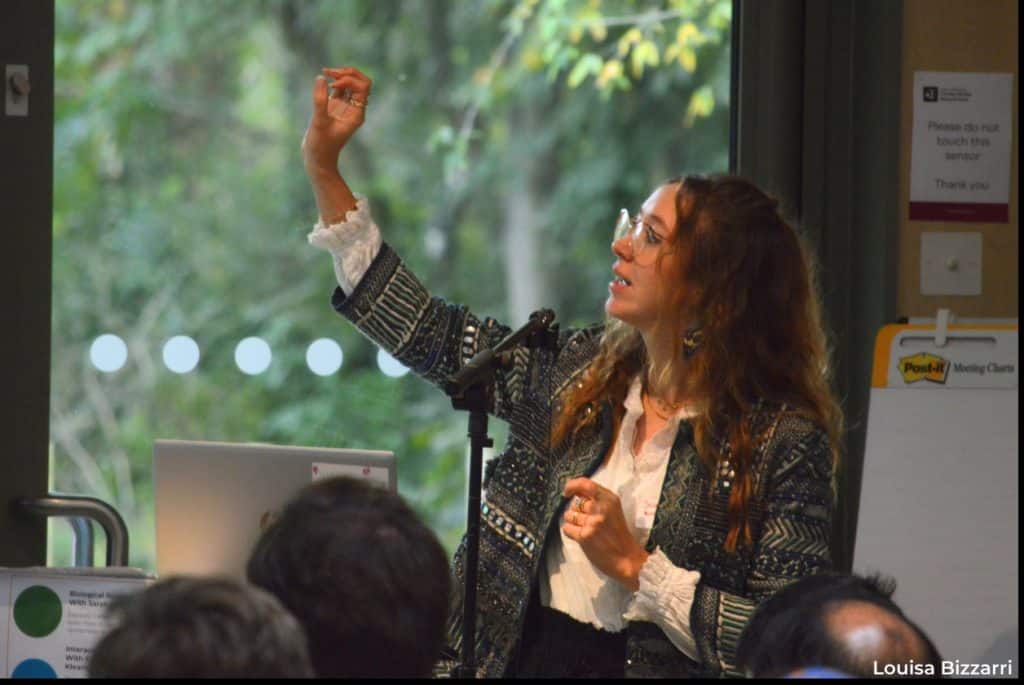
Bumblebees are important and beloved pollinators. Following two UK extinctions in the last century, many UK species are in decline, including seven rare, conservation-priority species. Five of the rare species are found in East London but evidence for species like Red-shanked and Ruderal bumblebees is limited by lack of recent data. Enabling and encouraging Londoners to record rare as well as common species will enable more accurate conservation assessments to be completed for all bumblebees and direct ecological interventions.
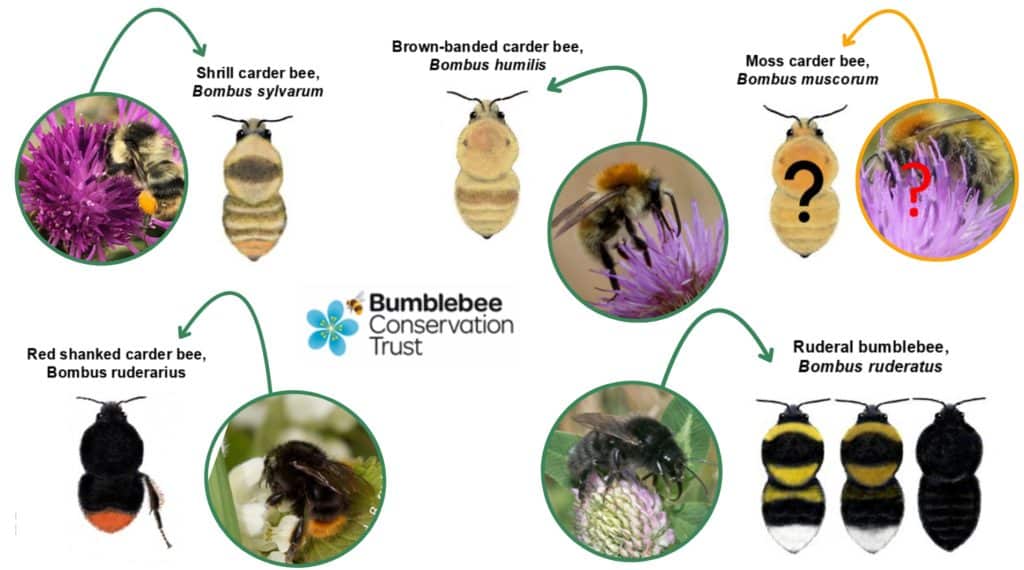
In just a year of initial funding from the Kusama Trust, B.E.E, in collaboration with action groups like Sustainably Muslim, has delivered 19 engaging workshops, surveyed 1160 hectares across London, established 10 new BeeWalk transects, generated over a million BeeWalk records on iRecord, identified clusters of rare bumblebee populations and even advised landowners on the creation of habitat corridors to link populations. A co-designed Community Consultation with Sustainably Muslim helped ensure the project had local concerns at heart – securing long-term and potentially self-sustaining impacts. The successes of the collaborative approach have allowed Scarlett and colleague Nikki Gammans to expand the work into the South London boroughs of Lewisham, Greenwich, Bexley and Bromley – areas rich in green space but notably lacking in recording efforts and recorders.
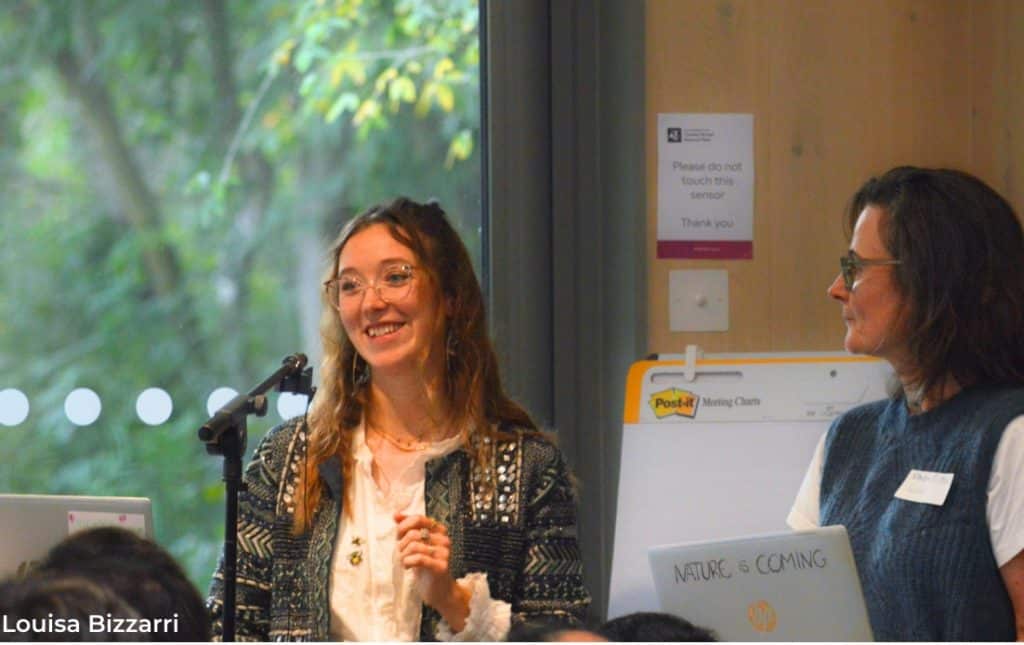
Observing and absorbing the changes in our natural surroundings was once essential to our daily lives. In today’s convenient, urbanised world, our connection to changes has faded. Projects like B.E.E help to restore it, by re-introducing strands of environmental awareness into the fabric of modern life. By engaging faith-based communities, B.E.E is both helping combat the chronic under-representation of minority ethnic groups in ecology, as well as tapping into the foundations of such groups, often already unified by a strong commitment to community stewardship.
Read about more of the achievements in the project’s six-month report here.
The Education Nature Park project, led by the Royal Horticultural Society and the Natural History Museum with support from Esri UK, is also helping to embed the curiosity and skills to develop budding young naturalists, from nursery to the end of secondary education. Funded by the Department of Education, the project is helping to formalise fading natural history education in general life as well as informal hobbies. Registration is free and participant schools are supplied with a toolkit full of curriculum-linked resources to connect students, parents and teachers alike to the natural environment of the school grounds.
Emma Woodhouse, Senior Project Officer, shared the iterative 5-step cycle every Education Nature Park programme employs. Students are encouraged to first collect baseline data from their school’s changing environment, and then use these to suggest evidence-informed decisions for improving the biodiversity of the school grounds. Assessing the implemented actions provides lessons closely linked to both the surrounding environment and the school science curriculum. School playing field turned real-world experiment, though, as one attendee noted, an experiment unfortunately lacking the funds of a research institution.
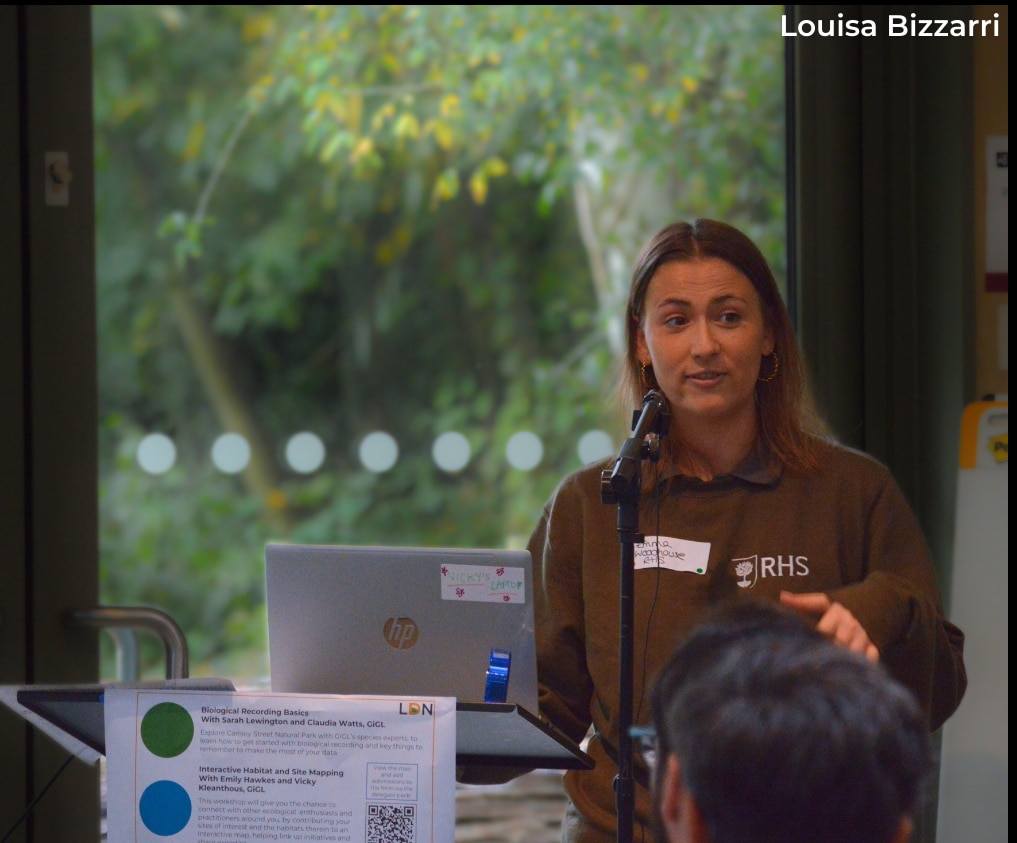
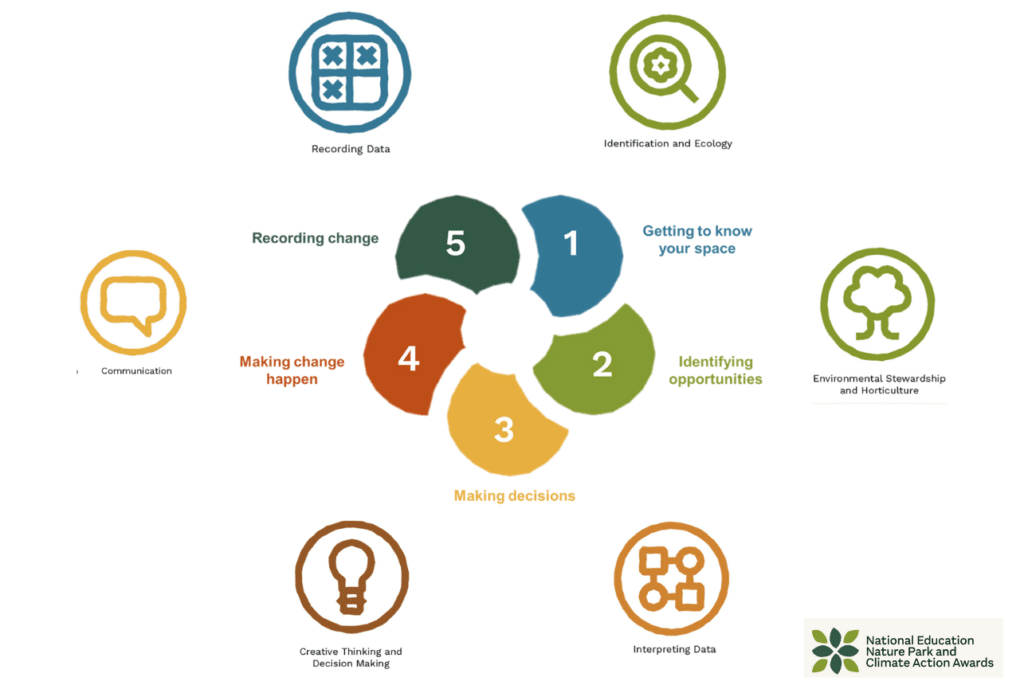
By enabling students to see the full cycle of their decision making, they gain responsibility for their environment, and are perhaps offered a sense of control to shield from the relentless gloom cast by climate headlines. High levels of overwhelming anxiety felt by young people are huge barriers to participation. Providing a sense of tangible control and simply helping kids to get outside regularly, will certainly have positive mental health outcomes. Reaping the benefits of healthier, calmer, more confident students, may well be a key incentive for any one of the 346 schools already registered in London. Hopefully the programme can help inspire the next cohort of recorders, verifiers and environmental stewards even if teachers and education budgets are stretched.
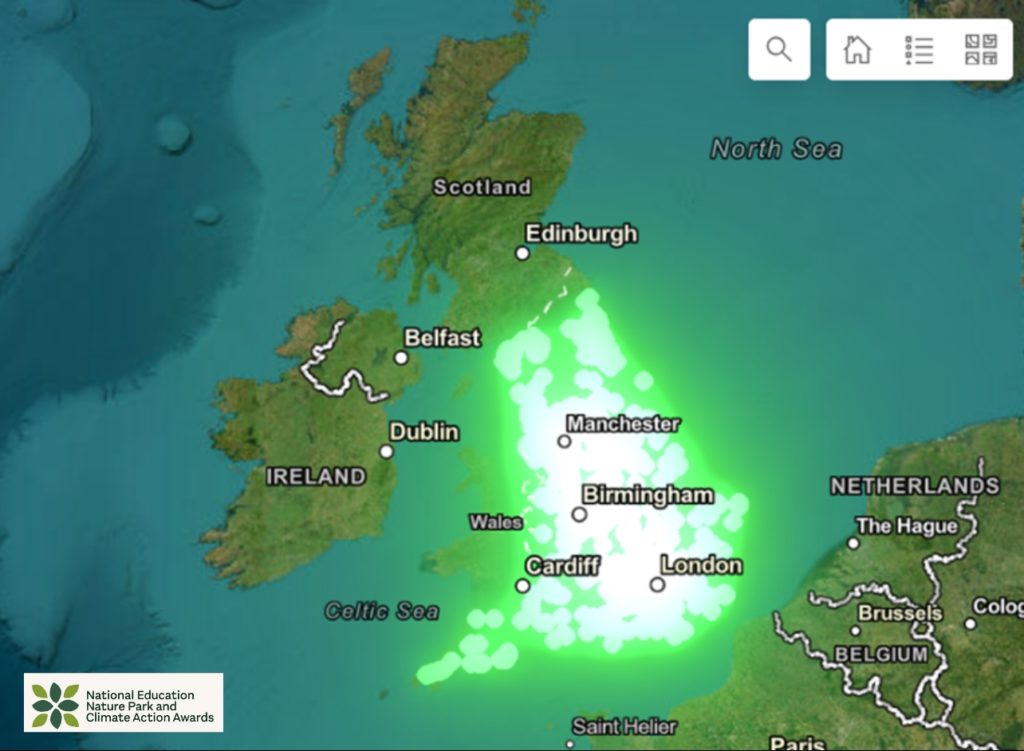
A Year in the Life of a LNHS Recorder
Long-term GiGL collaborators and stalwarts of London Day of Nature, members of the London Natural History Society (LNHS) gave presentations to inspire and enlist new verifiers to share the record verification load. In addition to the group’s updates provided by Keiron Derek Brown, Ecology and Entomology Chair for the LNHS, Bee and Wasp Recorder Tony Madgwick shared a year in the life of a species recorder.
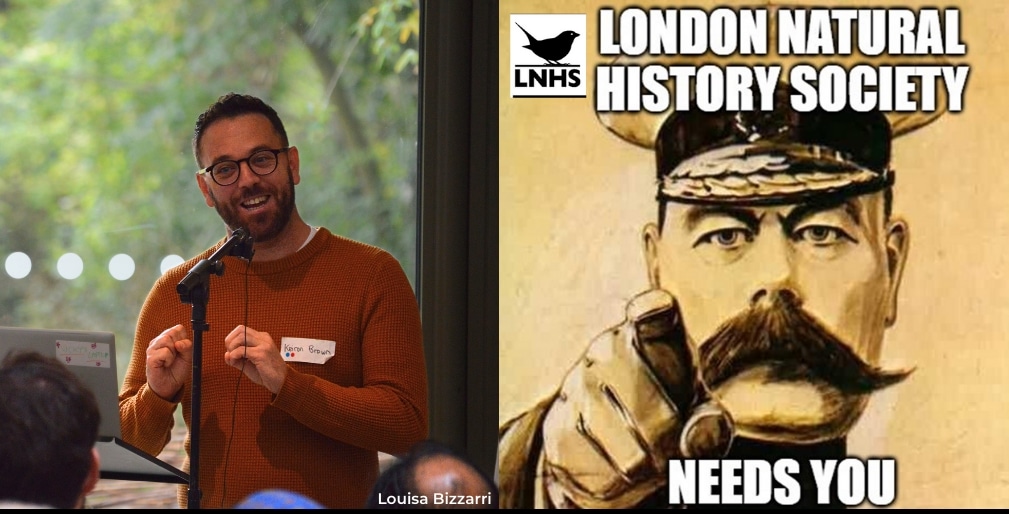
As both an LNHS and Bees Wasps & Ant Recording Society (BWARS) Recorder, Tony had a busy year, definitely somewhat obsessed by Hymenoptera. He shared his work not only recording, surveying and verifying Hymenoptera species as you might expect, but also educating, hosting field meetings, leading invertebrate study days at the Angela Marmont Centre and even helping to improve habitat for his beloved bees and wasps across key London sites. Queen Elizabeth Olympic Park in particular has made a surprising home to both common and rare species, including the surprising, pine-loving Passaloecus eremita, which Tony recorded on-site, in London for the first time. In another surprise, Tony also observed the organism shun a nesting site in a nearby pine woodland in favour of a lonely, neighbouring wooden fence post. The wasp preferred the wood of the post for its nest site, but still required a proximate source of pine tree resin to seal its nest. The story perfectly typified the LNHS’s special fusion of curiosity, academic study and activity.
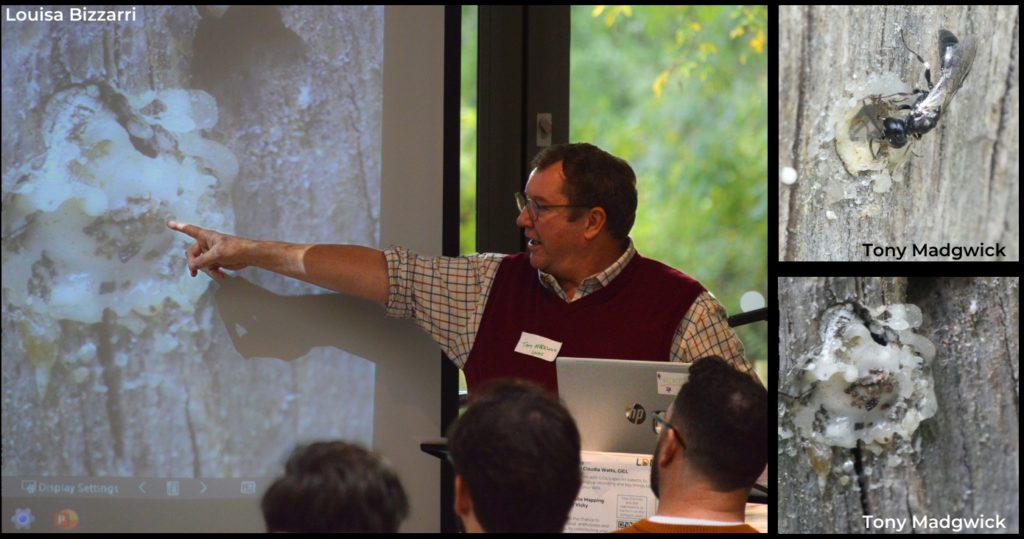
Tony’s love of detailed study also lends him to being a fastidious and instructive verifier. Always the educator, he also shared some best practice to make a verifiers life on iRecord a little easier – use your real name, share useful and clear images and please, please, please, be patient – he’ll get to your records soon!
You can read more tips on using recording apps like iRecord in our GiGLer article here.
View the full calendar of LNHS events , including talks and field events open to members and non-members here. The LNHS also regularly publish their detailed work documenting and monitoring London’s flora and fauna, and GiGL are particularly excited by the upcoming publication of the updated London’s Butterfly Atlas by last year’s LDN speaker, Leslie Williams. Be sure to also subscribe to Keiron’s Biological Recording Company newsletter for the latest talks, conferences and field days from BRC, EntoLive and the new MarineLive.
London’s ‘Wildbelt’ on the horizon?
We finished the talks with another LDN veteran and self-described ‘cultural ecologist’ – Mathew Frith, Director of Policy and Research for the London Wildlife Trust (LWT). Following on from last year’s dazzling dive into LWT’s project to document London’s glow worms, Mathew shared LWT’s vision for a ‘Wildbelt’ encircling the whole of Greater London.
Building on the 2023 final report from the Mayor of London’s Rewilding Taskforce and after several rounds of the Rewild Fund, the LWT have developed a landscape-scale nature recovery solution for London. Centred on Lawton’s principles for ‘bigger, better and more joined up’ habitats, the wildbelt would seek to protect, restore and expand 11 large ‘Wild Zones’ on the perimeter of London. Each proposed zone was analysed for practicability based on size, extent, connectivity and state of existing habitats, as well as species presence, land ownership and other environmental and social benefits. Devised for integration within the LNRS, the zones offer opportunities for large-scale nature gains, compliant with both the long-term strategy in London and with our neighbouring counties. For example, Zone 10 – Colne Valley and Ruislip Woods could easily extend northwest along the Colne catchment into Hertfordshire.
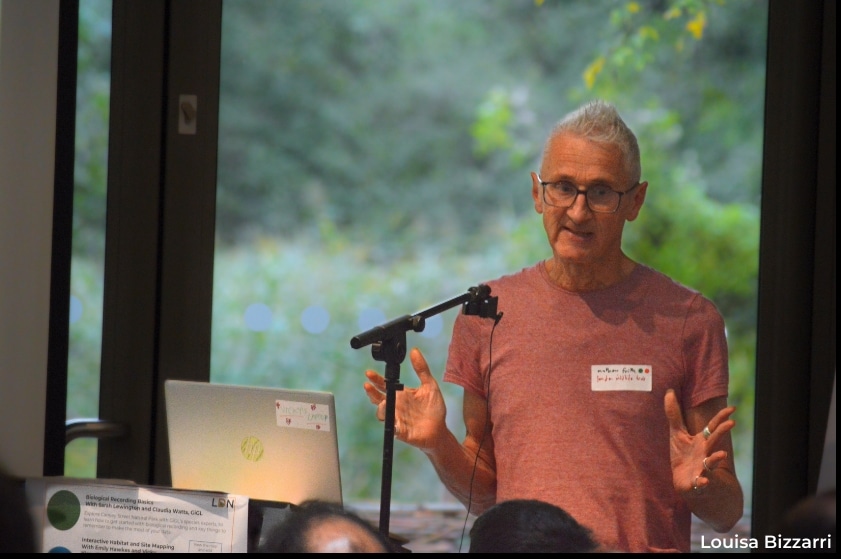
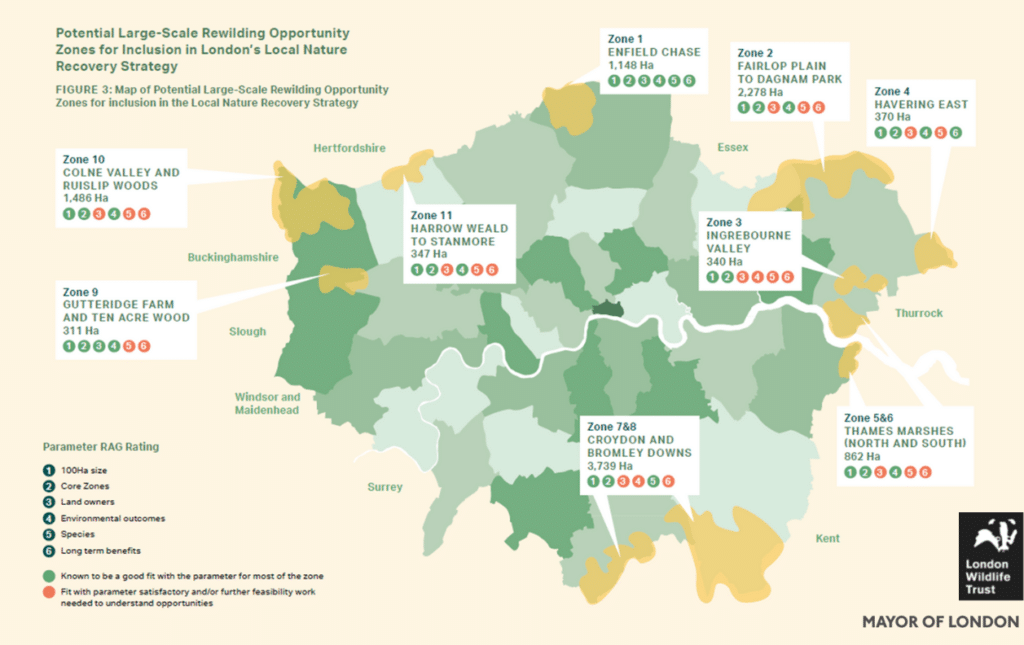
As Mathew and the Taskforce’s final report stress, and as demonstrated by the proposed zones, large-scale strategies must be developed specifically for ‘urban wilding’. Attempting to retrofit rural ‘rewilding’ principles, onto a city of complicated constraints, has not and will not work. ‘Rewilding’ is, at minimum definition, a slow process. Mimicking such principles across London’s valuable and complex landscape – owned by few, contested by many, inaccessible to most, heavily legislated against and polluted deeply to boot – seems uniquely slow and ill-suited.
As many of our speakers implored, knowing your local context is invaluable to restoring nature. With a significant career in nature in London, Mathew in particular is qualified to comment on both when and where human intervention is needed or should be limited within the city.
The Workshops
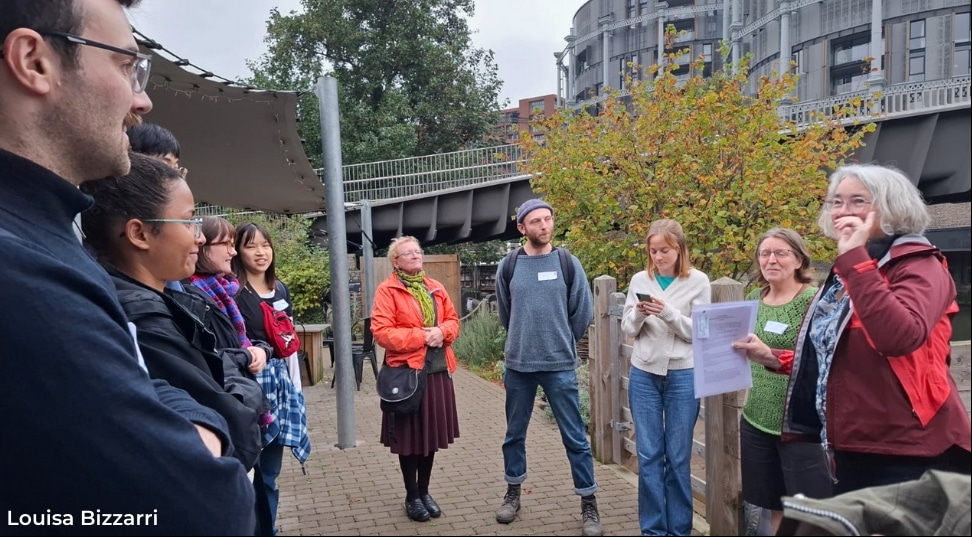
The final session of the day, was a choice of two out of three workshops, aimed at targeting different stages of a naturalist’s journey:
- In the Biological Recording Basics workshop, GiGLers Sarah and Claudia took intrepid attendees around Camley Street to get to grips with the basics of the ‘who’, ‘what’, ‘where’ and ‘when’ of a record. Digressions included how to provide accurate coordinates, the pros and cons of different recording apps, and the best resources for improving floral identification skills. With a range of skillsets at the workshop, it was clear that while there is no lack of knowledge in London, trying to fit it all into 20 minutes, was far too short!
Check out general resources from GiGL on biological recording.
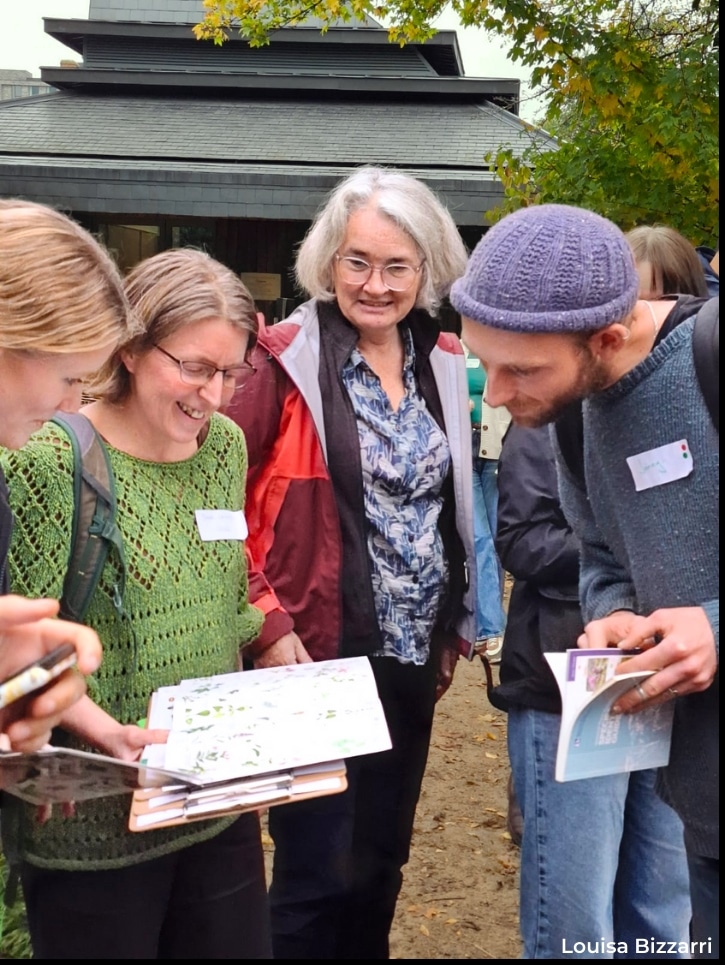
The second GiGL workshop, hosted by the author of this very article (Vicky), was called the ‘Interactive Site & Habitat Mapping’ workshop. Though slightly derailed by a technical glitch with our interactive map, the workshop instead debated the barriers to connecting like-minded individuals and ‘green actions’ across London, sustainably into the future. Much of the discussion centred around limited long-term funding opportunities to continue existing projects with staff and issues of ownership in collaborative projects. The phrase ‘bureaucratic violence’ might have been used… The overall message – invest your time and efforts wisely and while collaboration is key, set out individual responsibilities clearly!
Our interactive map, ‘Mapping Green Actions in London’ is now up and running and we would love for readers to submit details and locations of local green actions. By sharing where your group runs a regular bird transect or the location of a new wildlife pond, the fragmented mosaic habitats of London can be connected. The map can be used to link up local expertise by finding volunteer groups with specific ecological skills or equipment to share. Get inspired by checking out the map here and learn how to use it here.
Please don’t submit any personal details including individual names or home addresses to the interactive map. Please only include links to general email addresses, webpages or social media accounts. Only voluntary or grant-funded projects to be promoted, individual consulting services will be removed from the map.
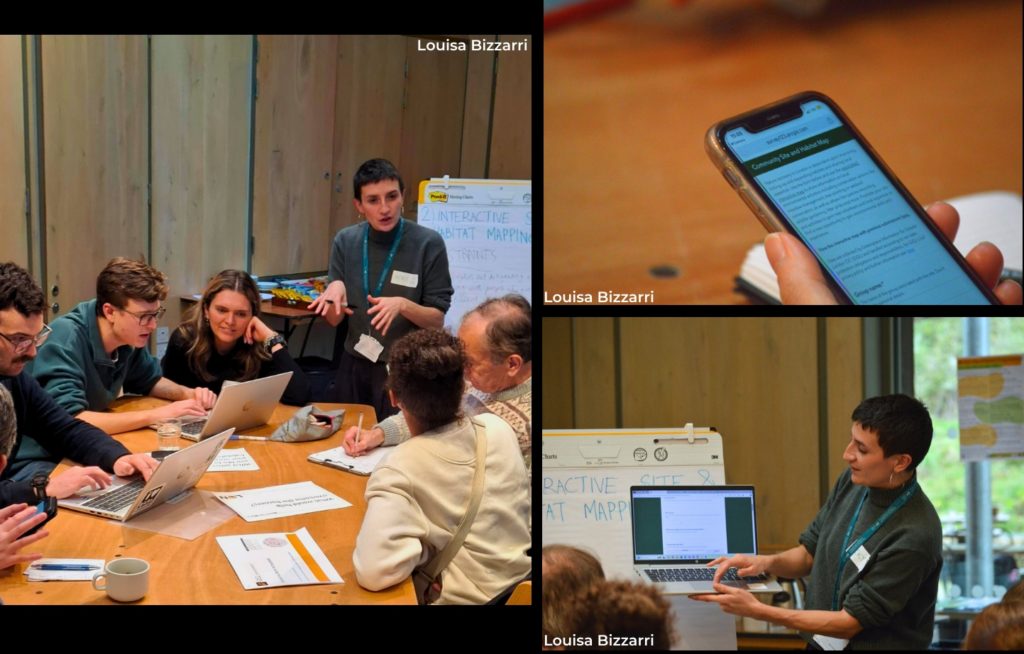
Our final workshop was delivered by the wonderful Denean Rowe of Planning Aid for London (PAL). PAL empower communities to understand their realm of influence within planning. With more sites under threat than ever before and the lofty aims of biodiversity net gain yet to materialise in London, understanding planning has never been more important. Denean took participants through the different stages of the planning process, to understand an individual can have influence, beginning with how to input into your borough’s Local Plan, to specifically what and how to comment on a planning application. GiGL and PAL are looking forward to collaborating together at future events to highlight the important link between species monitoring and protecting open spaces.
Check out PAL’s great resources for the public and for specific advice you can make an enquiry here.
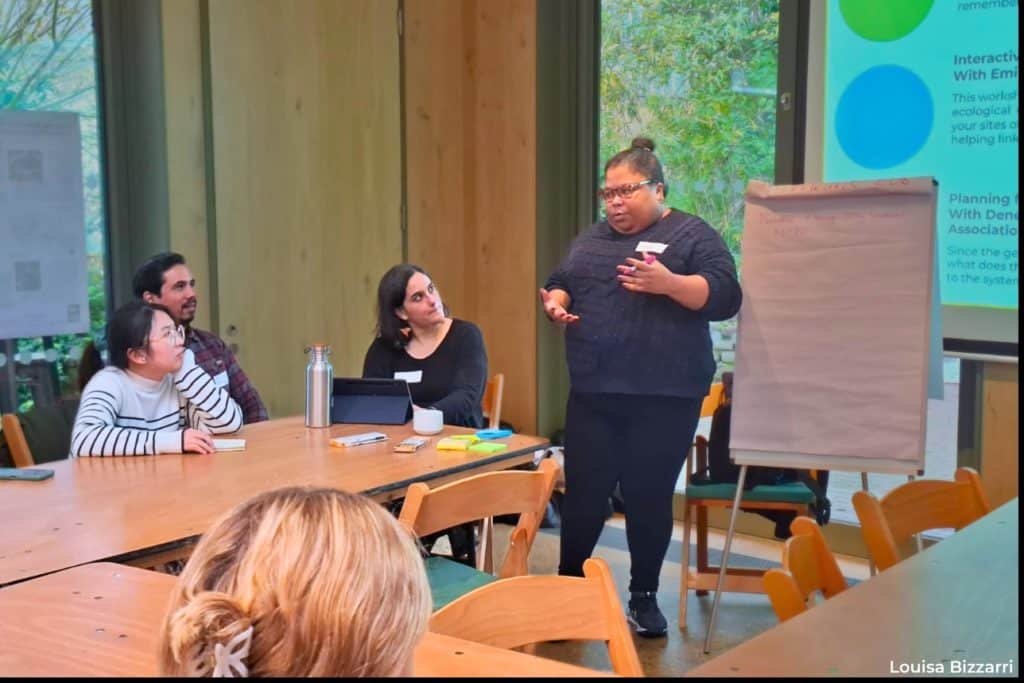
We hope that the workshops can help equip attendees to better understand the species and local habitats as well as how to protect them into the future. Feedback on the workshops over the years has been greatly appreciated as they can be tricky to keep engaging and discussion-inducing each year. Any feedback on how we could have better achieved the aim can be shared through our feedback form here.
Think Slow, Act Fast and Do It Together
From inspiring talks to stimulating discussions, London Day of Nature again left us assured of the knowledge, skill and generosity of the naturalist community in London. While none are in short supply in London, the day showed the need for strategic thinking in the projects we individually and collectively choose to support. We need to understand our individual and collective realms of influence to ‘think slow, act fast and do it together’.
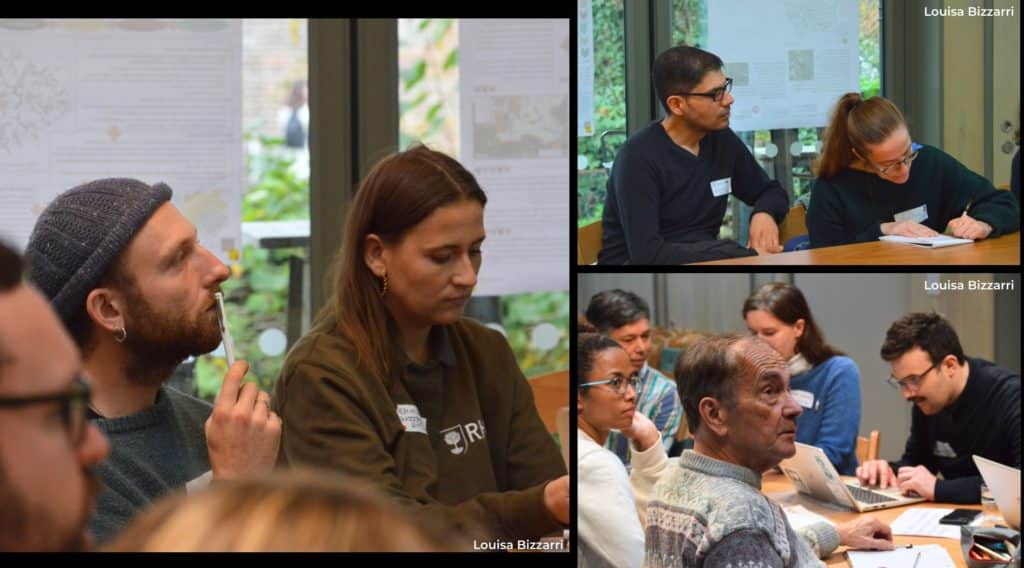
Thank you to everyone who got involved with note-taking, question-asking and workshopping on the day.
Education, policy and practice are work towards a common aim, but through different approaches and operating on different scales of feedback – a lifetime of learning, 3-10 years with a policy like the LNRS or through the daily implementation by many of our speakers stroke volunteers. Where these approaches can come into conflict is the absence of responsive feedback and communication mechanisms – institutions and bureaucracy think too slowly, burdened by process, while well-meaning practitioners can act too quickly without oversight, causing unintentional harm to nature. The brilliance of London Day of Nature (if I’m allowed to say that as an organiser…) is in bringing practitioners, policymakers, specialist educators and Londoners together to publicly discuss and respond to one another’s methods and philosophies. When we celebrate and think deeply about each other’s ideas towards nature, more nuanced practices develop. Diverse opinions and approaches are needed to enhance London’s natural environment and the LDN events continue to serve as a chance to reflect that, while we may speak from different vantages, we are all part of the same town square.
You can find links to the work of all speakers in our virtual Delegate Pack, where you can also find the feedback form (hint hint). You can also help GiGL in our mission to connect habitat interventions across London by adding to our interactive map.
Contact me through Victoria.kleanthous@gigl.org.uk
